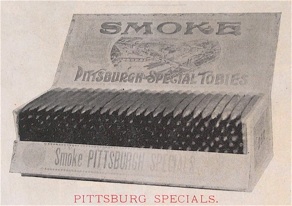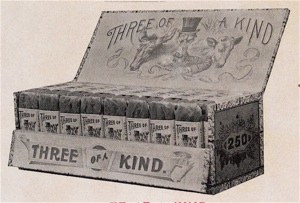Nailed wood boxes of 250 are one of the oldest forms of cigar box, dating back to the earliest days of international commerce in cigars. In the first half of the 1800’s these were called “quarter boxes” as a “box of cigars” contained 1,000. In 1865 they became one of the five official sizes of cigar box permitted by the federal government. Although boxes of 500 were also legal, they proved impractical and boxes of 250 became the largest boxes of cigars in regular commerce.
In the second half of the 1800’s large boxes were used for cheap (frequently 3/5¢) cigars, and were typically trimmed with inexpensive mono-chromatic labels making those with colorful labels fine prizes for collectors today. The use of large boxes for cheap cigars was a matter of economics. Profit margins on cigars in general were small, but downright miniscule on cigars that wholesaled for a penny or penny and a quarter and retailed at
3/5¢. One box that would hold and display 250 cigars was a lot cheaper to obtain from the box maker than five boxes that held 50 each. Less wood, less labor, and many fewer labels resulted in a few more pennies in the cigarmaker’s till.
Photos from 1897 Jenkinson catalog [2056] [2053]
Most, but not all, NW 250 boxes have dropfronts so that customers can see the cigars, whether packed laying down or upright in bands, sleeves or paper bundles. Dropfront boxes require an overall lid, rather than an inset. Over the years, many empty 250’s have had their dropfronts nailed shut by owners attempting to make the empty box useful. Most surviving NW 250’s appear to date 1883-1909 and the vast majority held cigars made in Eastern Ohio or Western Pennsylvania.



